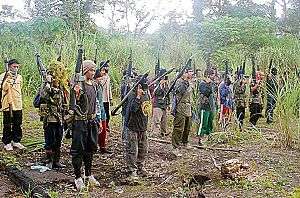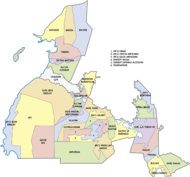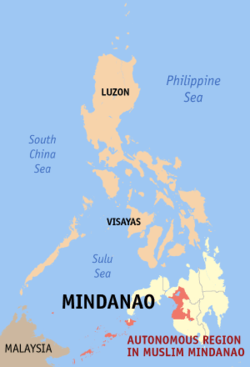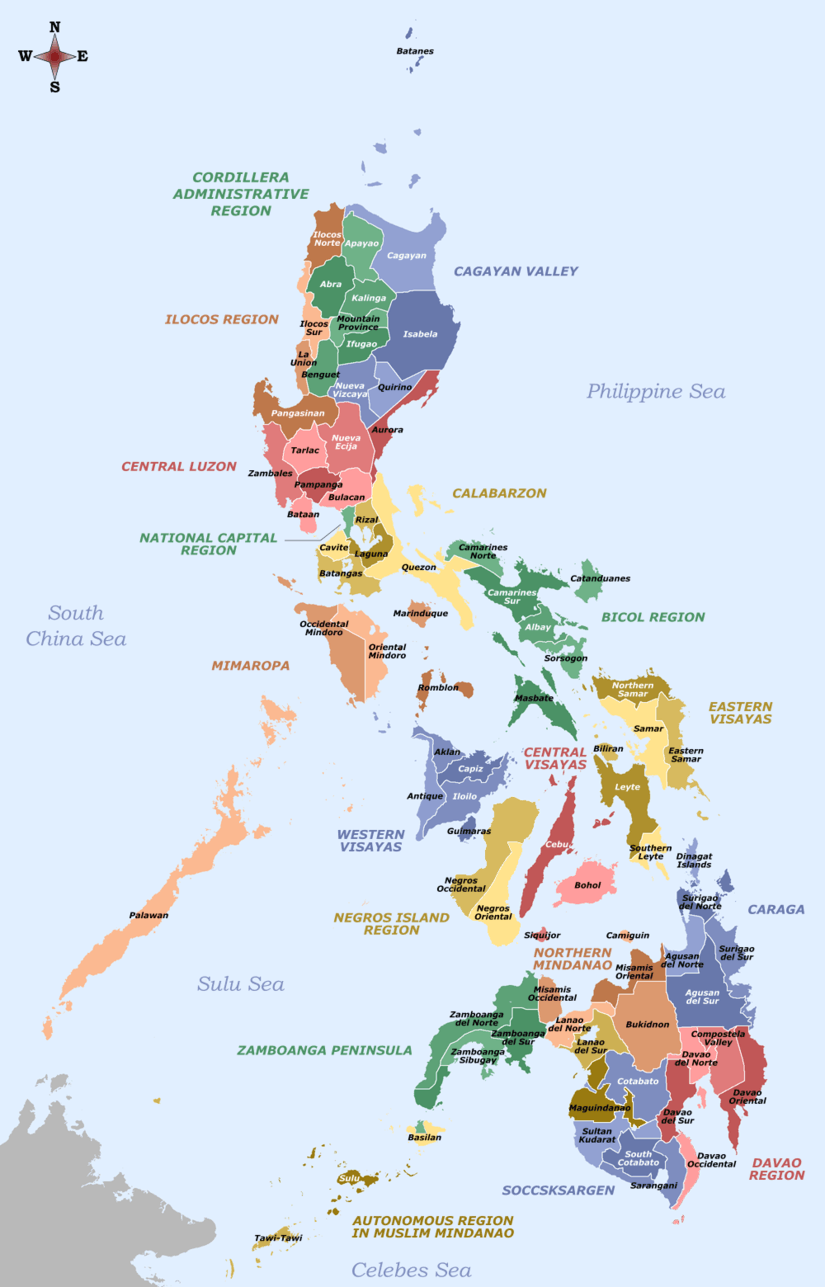Maguindanao
Maguindanao (Maguindanaoan: Dalapa sa Maguindanao; Cebuano: Lalawigan sa Maguindanao; Hiligaynon: Kapuoran sang Maguindanao; Chavacano: Provincia de Maguindanao; Filipino: Lalawigan ng Maguindanao) is a province in the Philippines located in the Autonomous Region in Muslim Mindanao (ARMM). Since 2014 the provincial capital is Buluan[4] but the legislative branch of the provincial government, the Sangguniang Panlalawigan, convenes in the old provincial capitol in the town of Sultan Kudarat.[5] It borders Lanao del Sur to the north, Cotabato to the east, Sultan Kudarat to the south, and the Illana Bay to the west.
History
Precolonial and Spanish eras
Shariff Mohammed Kabungsuwan of Johore introduced Islam in the area at the end of the 15th century. He subsequently married a local princess from the Maranao Tribe of Malabang and Maguindanao Province, and established the Sultanate of Maguindanao. The Cotabato Valley formed the sultanate's heartland but its influence extended from the Zamboanga Peninsula to Sarangani Bay and Davao.
The Spaniards launched expeditions to subdue the area throughout the colonial era but they never gained control of the region until the middle of the 19th century after the Spaniards established a military post at what is now Barangay Tamontaka, one of the earliest Christian settlements founded south of the Philippines, in present-day Cotabato City. Spaniards already took with them Chabacanos and Chabacano-speaking Muslims from Zamboanga and Basilan and Cebuanos. Chabacanos being brought by Spaniards are the reason of existing Chabacano dialect in Cotabato City called Cotabateño, evolved from Zamboangueño.
American Era and World War II
The historical province of Cotabato covered the present area of Maguindanao. In 1903, the American colonial government established the Moro Province and made Cotabato as one of its districts. Upon the conversion of the Moro Province into the Department of Mindanao and Sulu in 1914, the districts were made into provinces.[6][7]
In 1942, the Japanese Imperial forces entered what is now Maguindanao.
In 1945, Maguindanao was liberated by allied Philippine Commonwealth troops and Maguindanaoan guerrilla units after defeating the Japanese Imperial forces in the Battle of Maguindanao during the Second World War.
Creation as a province
The territory of the old province of Cotabato was reduced in 1966 when several of its municipalities were separated from it and constituted into the newly-created province of South Cotabato.[8] In 1973, Cotabato was dissolved when it was split to create three new provinces: Maguindanao, (North) Cotabato and Sultan Kudarat.[9]
Maguindanao is the only Muslim-majority province of the four created out of the original Cotabato Province. In 1989, majority of its voters opted to join the Autonomous Region in Muslim Mindanao but Cotabato City did not, which, ironically, has since served as the provisional capital of the Autonomous Region in Muslim Mindanao (ARMM).
Shariff Kabunsuan creation and nullification
On October 31, 2006, Maguindanao voters approved the creation of a new province to be composed of 10 towns from the province.[10] Of more than 500,000 voters registered, 285,372 favored the creation of the province, and 8,802 voted against it. The new province, Shariff Kabunsuan, established through Muslim Mindanao Autonomy Act No. 201 by the ARMM Regional Legislative Assembly, became the country's 80th province and the 6th in the ARMM. It was composed of the towns of Datu Odin Sinsuat, Kabuntalan, Upi, Sultan Kudarat, Datu Blah T. Sinsuat, Sultan Mastura, Parang, Buldon, Matanog and Barira.[11] However, in July 2008, the Supreme Court, in an 8-6 vote, nullified the province's creation, restoring its municipalities to Maguindanao, ruling that "Only Congress can create provinces and cities because the creation of provinces and cities necessarily includes the creation of legislative districts".[12]
2009 election violence

On November 23, 2009, a 2010 gubernatorial election caravan supporting Esmael Mangudadatu, vice mayor of Buluan, was attacked.[13] Fifty-seven people were killed, including Mangudadatu's wife and sisters, supporters, local journalists, and bystanders.[14] On December 4, 2009, a number of homes belonging to the Ampatuan political family were raided in connection with the massacre.[15]
President Gloria Macapagal Arroyo officially declared martial law in the province of Maguindanao on December 5, 2009, Saturday morning.[16]
In a press conference past 7 am, Executive Secretary Eduardo Ermita announced Proclamation No. 1959 declaring a state of martial law and suspending the privilege of the writ of habeas corpus in the province of Maguindanao, except for certain areas identified as bailiwicks of the Moro Islamic Liberation Front (MILF) separatists.[17]
The declaration of martial law led to the "arrests without warrants" of other members of the Ampatuan clan who have been linked to the November 23 massacre of 58 civilians.[18]

On August 15, 2011, Mangudadatu and his convoy were ambushed as they were on their way to his birthday celebration.
Mamasapano clash
On January 25, 2015, 44 members of the Special Action Force were killed after they killed the Jemaah Islamiyah terrorist Zulkifli Abdhir aka Marwan, by allegedly Moro Islamic Liberation Front and Bangsamoro Islamic Freedom Fighters in Mamasapano, Maguindanao.[19][20]
2016 El Niño
On February 2016, Maguindanao experienced the effects of the 2014–16 El Niño, causing destruction on rice and corn fields due to drought.[21] The province declared a state of calamity in response to the damages caused.[21]
Geography

Maguindanao is situated in the central section of Mindanao, bordered by Lanao del Sur to the north, Cotabato to the east, Sultan Kudarat to the south, and the Illana Bay to the west.
Administrative divisions
Maguindanao comprises 36 municipalities, further subdivided into 508 barangays. Cotabato City, although geographically grouped with Maguindanao, is administratively independent from the province as well as from the ARMM.
The province is divided into two congressional districts. In October 2006, the first congressional district was split off into a new province, Shariff Kabunsuan. However, the ARMM's Act creating the province was nullified by the Supreme Court in July 2008, on the basis that creation of a province is a function of the Philippine legislature. The area has since reverted to the province of Maguindanao.
- † Capital municipality
- Municipality
- ∗∗ Independent component city (only geographically grouped with the province)
| ||||||||||||||||||||||||||||||||||||||||||||||||||||||||||||||||||||||||||||||||||||||||||||||||||||||||||||||||||||||||||||||||||||||||||||||||||||||||||||||||||||||||||||||||||||||||||||||||||||||||||||||||||||||||||||||||||||||||||||||||||||||||||||||||||||||||||||||||||||||||||||||||||||||||||||||||||||||||||||||||||||||||||||||||||||||||||||||||||||||||||||||||||||||||||||||||||||||||||||||||||||||||||||||||||||||||||||||||||||||||||||||||||||||||||||||||||||||||||||||||||||||||||||||||||||||||||||||||||||||||||||||
Demographics
| Population census of Maguindanao | ||
|---|---|---|
| Year | Pop. | ±% p.a. |
| 1980 | 452,675 | — |
| 1990 | 630,674 | +3.37% |
| 1995 | 662,180 | +0.92% |
| 2000 | 801,102 | +4.17% |
| 2007 | 1,273,715 | +6.60% |
| 2010 | 944,718 | −10.30% |
| 2015 | 1,173,933 | +4.22% |
| (excluding Cotabato City) Source: Philippine Statistics Authority[2][23][26] | ||
The population of Maguindanao in the 2015 census was 1,173,933 people. When Cotabato City is included for geographical purposes, the province's population is 1,473,371 people.
The majority of people in Maguindanao are Maguindanao people, with some Cebuanos, Ilonggos, Chavacanos, Tausugs, Yakan, and Bajau.
The main language is Maguindanao. Cebuano, Hiligaynon and Chavacano are also spoken by both, Christians and Muslims. The dialect of Chavacano native to Cotabato City is called Cotabateño, which evolved from the Zamboangueño dialect. Also spoken are Tagalog, as well as English and Arabic.
Religion
Maguindanao inhabitants are predominantly practitioners of Islam, majority of which are Sunnites, with a minority of Christians, (mostly Roman Catholics) who are mostly Cebuanos, Ilonggos and Chavacanos. Roman Catholics of Maguindanao fall under the jurisdiction of the Roman Catholic Diocese of Kidapawan, a suffragan of the Archdiocese of Cotabato. Iglesia ni Cristo (INC) has several locales in Maguindanao.
Government
Maguindanao is divided into two congressional districts, which elect members to the House of Representatives. For the brief period that the province of Shariff Kabunsuan existed, Maguindanao became a lone-district province. Since the appointment of a new set of provincial officials for the reunified province of Maguindanao by the ARMM Governor in January 2009, the provincial government has reverted to the Sangguniang Panlalawigan setup (coterminous with the restored 1st and 2nd Congressional districts of Maguindanao) from before Shariff Kabunsuan was created.

Having elected to join the Autonomous Region in Muslim Mindanao (ARMM), Maguindanao also sends six representatives (three per district) to the ARMM Regional Legislative Assembly that convenes in Cotabato City.
Provincial capital
When the province was established in 1973, the designated seat of government was the municipality of Maganoy.[9] The first appointed governor, Simeon Datumanong, held office in Brgy. Limpongo,[27] which is now a part of the municipality of Datu Hoffer Ampatuan. His successor Zacaria Candao, on the other hand, held office at P.C. Hill,[27] the site of the former headquarters of the Philippine Constabulary[28] in Cotabato City, an autonomous chartered city not under Maguindanao's provincial jurisdiction.
In 1977 following the resignation of Candao President Ferdinand Marcos moved the seat of government of the province to the town of Sultan Kudarat (hometown of the newly-appointed governor Sanggacala Baraguir) by virtue of Presidential Decree No. 1170.[29] During his term Baraguir held office at the newly-constructed provincial capitol in that municipality's Brgy. Simuay Crossing.[27]
After the election of Sandiale Sambolawan as governor in 1980, he held office in his hometown of Maganoy.[27] Batas Pambansa Blg. 211, passed in 1982, was supposed to restore Maguindanao's capital to Maganoy (and in effect legitimize the change in seat of government under Sambolawan's term), but only after a plebiscite affirms the transfer.[30] A plebiscite scheduled for December 18, 1982[31] was never administered,[32] making the law not legally binding. Following the end of the Marcos Regime, the next two governors — Zacaria Candao (1986–1992; 1995–2001) and Norodin Matalam (1992–1995) — held office in the existing capitol at Sultan Kudarat, which had been the de jure capital since 1977.
Despite the lack of legal justification in the form of a law amending P.D. No. 1170 of 1977 or the passage of a supporting Sangguaniang Panlalawigan resolution, the next governor, Andal Ampatuan Sr. (governor from 2001–2008), and his successor, son Sajid Ampatuan (2008–2009), held office in the Ampatuan clan stronghold of Shariff Aguak, citing security concerns connected to clan rivalry.[5] A new P218-million provincial capitol complex, inaugurated in 2009 in the presence of President Gloria Macapagal-Arroyo,[33] was located adjacent to the homes of the Ampatuans,[27] and sat on a piece of Amaptuan clan land that had not been legally deeded to the government.[34] The Ampatuans were even known to spend more time within the "satellite offices" they set up within their private properties, despite though the new capitol being located adjacent to their homes.[35]
Esmael Mangudadatu, who took office after defeating Andal Ampatuan, Jr. in the 2010 gubernatorial election, cited security concerns when he decided to work from a "satellite office," named the Rajah Buayan Silongan Peace Center, in his hometown of Buluan;[27] this move was supported by Resolution No. 5, series 2010 of the Sangguniang Panlalawigan (SP) of Maguindanao.[36] SP Resolution No. 78, dated to May 3, 2011, further allowed the transfer of the legislative branch of the provincial government (Sangguniang Panlalawigan) to the rehabilitated old capitol site in Brgy. Simuay Crossing, Sultan Kudarat.[5] This effectively made both Buluan and Sultan Kudarat — located 120 kilometers apart by road — the seats of the executive and legislative branches of provincial government respectively.[35]
On April 3, 2012 the Sangguniang Panlalawigan of Maguindanao issued Resolution No. 132, reiterating that the town of Sultan Kudarat was the capital of Maguindanao.[5] However this was superseded by a new resolution passed in 2014 naming Buluan the new capital of Maguindanao.[4] Buluan's Rajah Buayan Silongan Peace Center now serves as the provisional capitol building, pending the completion of the executive building in the new capitol complex.[27] However, the legislative branch of provincial government, the Sangguniang Panlalawigan of Maguindanao, continues to hold sessions in the rehabilitated buildings of the old provincial capitol in Simuay, Sultan Kudarat.[5]
The Ampatuan-built former provincial capitol complex in Shariff Aguak, initially planned to be converted for public school use,[37] is now set to become the new headquarters of the ARMM's Bureau of Fire Protection.[38]
Musical heritage
The native Maguindanaon culture revolves around kulintang music, a specific type of gong music, found among both Muslim and non-Muslim groups of the Southern Philippines.
References
- ↑ "ARMM Regional Profile". Regional Board of Investments (RBOI) of the Autonomous Region in Muslim Mindanao (ARMM). Retrieved 22 June 2016. (There seems to be major discrepancies among authoritative sources: 972,904 ha (NSCB); 6,565 km² (Historical Dictionary of the Philippines); 5,176.1 km² (NAMRIA))
- 1 2 3 Census of Population (2015): Highlights of the Philippine Population 2015 Census of Population (Report). PSA. Retrieved 20 June 2016.
- ↑ "Provincial Summary - Number of Provinces, Cities, Municipalities and Barangays, by Region, as of December 31, 2013" (PDF). PSGC Interactive. National Statistical Coordination Board. Retrieved 30 May 2014.
- 1 2 Macabalang, Ali G. (19 January 2016). "Construction of new Maguindanao capitol complex launched". Manila Bulletin Online. Retrieved 1 August 2016.
- 1 2 3 4 5 Arguillas, Carolyn O. (15 June 2012). "Maguindanao inaugurates legislative hall; Sultan Kudarat is back as provincial seat". MindaNews. Retrieved 1 August 2016.
- ↑ "Our Province". Province of Cotabato. Retrieved 27 April 2016.
- ↑ "Act No. 2711; An Act Amending the Administrative Code". Official Gazette of the Republic of the Philippines. 10 March 1917. Retrieved 27 April 2016.
- ↑ "Republic Act No. 4849 - An Act Creating the Province of South Cotabato". Chan Robles Virtual Law Library. 18 July 1966. Retrieved 15 April 2016.
- 1 2 "Presidential Decree No. 341 - Creating the Provinces of North Cotabato, Maguindanao and Sultan Kudarat". Official Gazette of the Republic of the Philippines. Malacañang, Manila, Philippines. 22 November 1973. Retrieved 15 April 2016.
- ↑ Unson, John (29 October 2006). "Maguindanao split decided in plebiscite". The Philippine Star. Retrieved 28 January 2016.
- ↑ "Muslim Mindanao Autonomy Act No. 201; An Act Creating the Province of Shariff Kabunsuan, Providing Funds Therefor, and for Other Purposes" (PDF). Regional Legislative Assembly, Autonomous Region in Muslim Mindanao. Retrieved 27 January 2016.
- ↑ Llanto, Jesus F. (16 July 2008). "Supreme Court voids creation of Shariff Kabunsuan". ABS-CBN News. Archived from the original on 27 January 2016. Retrieved 27 January 2016.
- ↑ Conde, Carlos H. (November 23, 2009). "21 Reported Dead and 22 Missing in Mass Kidnapping Linked to Philippine Election". The New York Times. Retrieved November 27, 2009.
- ↑ Conde, Carlos H. (November 27, 2009). "Philippine Official Says Victims Were Sexually Mutilated". The New York Times. Retrieved November 27, 2009.
- ↑ "Officials raid massacre suspects' homes". Radio France Internationale (RFI). 4 December 2009. Retrieved 15 April 2016.
More than 100 soldiers and police wearing body armour and carrying assault rifles raided the home of Andal Ampatuan Jnr and other Ampatuan clan members on Friday. This followed the discovery of a weapons cache on Thursday, believed to have been used in the massacre, near the Ampatuan compound. It is thought there were enough weapons to arm around 500 people.
- ↑ "Martial law in Philippines province after massacre". BBC News. 5 December 2009.
- ↑ Padua, Reinir (6 December 2009). "'Martial law a political solution'". The Philippine Star. Retrieved 15 April 2016.
- ↑ "Arroyo proclaims martial law in Maguindanao". ABS-CBN News. 5 December 2009.
- ↑ "At least 30 elite cops killed in clash with MILF". ABS-CBN News. Retrieved January 25, 2015.
- ↑ Arcon, Dennis (January 26, 2015). "PNP-SAF casualties in encounter now 50 - ARMM police chief". Interaksyon. Retrieved January 26, 2015.
- 1 2 Unson, John (February 5, 2016). "Maguindanao farmers lose crops due to El Niño". Philstar Global. Philstar. Philippine Star. Retrieved February 20, 2016.
- 1 2 "Province: Maguindanao". PSGC Interactive. Quezon City, Philippines: Philippine Statistics Authority. Retrieved 8 January 2016.
- 1 2 Census of Population and Housing (2010): Population and Annual Growth Rates for The Philippines and Its Regions, Provinces, and Highly Urbanized Cities (PDF) (Report). NSO. Retrieved 29 June 2016.
- ↑ "Brief Profile". Provincial Government of Maguindanao. Archived from the original on 15 April 2015. Retrieved 15 April 2016.
Land Area; Maguindanao has a total land area of 597,052.79 hectares.
- ↑ "PSGC Interactive; List of Provinces". Philippine Statistics Authority. Retrieved 29 March 2016.
- ↑ "ARMM - Autonomous Region in Muslim Mindanao". Census of Population and Housing (2010): Total Population by Province, City, Municipality and Barangay (Report). NSO. Retrieved 29 June 2016.
- 1 2 3 4 5 6 7 Lingao, Ed (April 2013). "Maguindanao's misery: Absentee officials, absence of rage, poverty". Retrieved 1 August 2016.
- ↑ McKenna, Thomas M. (1998). Muslim Rulers and Rebels: Everyday Politics and Armed Separatism in the Southern Philippines. University of California Press. p. 327.
- ↑ "Presidential Decree No. 1170 - Transferring the seat of government of the province of Maguindanao from the municipality of Maganoy to the Municipality of Sultan Kudarat". Official Gazette of the Republic of the Philippines. Malacañang, Manila, Philippines. 11 July 1977. Retrieved 1 August 2016.
- ↑ "Batas Pambansa Blg. 211 - An Act returning the seat of government of the Province of Maguindanao from the Municipality of Sultan Kudarat to the Municipality of Maganoy, repealing for the purpose Presidential Decree numbered eleven hundred and seventy". The Corpus Juris. 25 March 1982. Retrieved 1 August 2016.
- ↑ "Proclamation No. 2245, s. 1982 - Declaring December 18, 1982 as the Plebiscite Day for the ratification of the proposal to return the seat of government of the Province of Maguindanao from the Municipality of Sultan Kudarat to the Municipality of Maganoy". Official Gazette of the Republic of the Philippines. Malacañang, Manila, Philippines. 26 November 1982. Retrieved 1 August 2016.
- ↑ Unson, John (12 June 2014). "Law changing Maguindanao's capitol pushed". Philstar.com. Retrieved 1 August 2016.
- ↑ "Arroyo visits ARMM, pledges more support; praises Ampatuan leadership". Mindanao Examiner. 31 March 2009. Retrieved 1 August 2016.
- ↑ Unson, John (20 January 2016). "Maguindanao gov't starts construction of new capitol complex". The Philippine Star. Retrieved 4 November 2016.
- 1 2 Arguillas, Carolyn O. (19 October 2010). "From Ampatuan to Mangudadatu (1): Changing the image of Maguindanao". MindaNews. Retrieved 1 August 2016.
- ↑ Arguillas, Carolyn O. (20 October 2010). "From Ampatuan to Mangudadatu (2): Mobile Capitol". MindaNews. Retrieved 1 August 2016.
- ↑ Fernandez, Edwin (8 June 2014). "Maguindanao provincial building to be converted into school". Philippine Daily Inquirer. Retrieved 1 August 2016.
- ↑ "Old Maguindanao capitol in Shariff Aguak town up for conversion to BFP-ARMM headquarters". Radyo Natin. 29 September 2016. Retrieved 4 November 2016.
External links
-
 Media related to Maguindanao at Wikimedia Commons
Media related to Maguindanao at Wikimedia Commons -
 Maguindanao travel guide from Wikivoyage
Maguindanao travel guide from Wikivoyage -
 Geographic data related to Maguindanao at OpenStreetMap
Geographic data related to Maguindanao at OpenStreetMap - COMELEC Resolution No. 8169
- COMELEC Plebiscite Results for 3 new Maguindanao municipalities
- Local Governance Performance Management System
 |
Illana Bay | Lanao del Sur |  | |
| Moro Gulf | |
Cotabato | ||
| ||||
| | ||||
| Celebes Sea | Sultan Kudarat |





